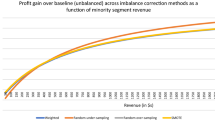Abstract
Data Mining is a widely used discipline with methods that are heavily supported by statistical theory. Game theory, instead, develops models with solid economical foundations but with low applicability in companies so far. This work attempts to unify both approaches, presenting a model of price competition in the credit industry. Based on game theory and sustained by the robustness of Support Vector Machines to structurally estimate the model, it takes advantage from each approach to provide strong results and useful information. The model consists of a market-level game that determines the marginal cost, demand, and efficiency of the competitors. Demand is estimated using Support Vector Machines, allowing the inclusion of multiple variables and empowering standard economical estimation through the aggregation of client-level models. The model is being applied by one competitor, which created new business opportunities, such as the strategic chance to aggressively cut prices given the acquired market knowledge.
Access this chapter
Tax calculation will be finalised at checkout
Purchases are for personal use only
Preview
Unable to display preview. Download preview PDF.
Similar content being viewed by others
References
Cristiannini, N., Shawe-Taylor, J.: An Introduction to Support Vector Machines and Other Kernel-Based Methods. Cambridge University Press, Cambridge (2003)
Dubé, J., Chintagunta, P., Bronnenberg, B., Goettler, R., Petrin, A., Seetharaman, P., Thomadsen, R., Zhao, Y.: Structural applications of the discrete choice model. Marketing Letters 13(3), 207–220 (2002)
Dubé, J., Manchanda, P.: Differences in dynamic brand competition across markets: An empirical analysis. Marketing Science 24(1), 81–95 (2005)
Faires, J.D., Burden, R.: Numerical Analysis. Thomson Brooks/Cole (1986)
Friedman, J.: A non-cooperative equilibrium for supergames. Review of Economic Studies 38, 112 (1971)
Fudenberg, D., Tirole, J.: Game Theory. MIT Press, Cambridge (1991)
Hornik, K., Stinchcombe, M., White, H.: Multilayer feedforward networks are universal approximators. Neural Networks 2(5), 359–366 (1989)
Nash, J.: Non-cooperative games. Annals of Mathematics 54, 286–295 (1951)
Rifkin, R., Klautau, A.: In defense of one-vs-all classification. The Journal of Machine Learning Research 5, 101–141 (2004)
Rotemberg, I., Saloner, G.: A super-game theoretic model of business cycles and price wars during booms. American Economic Review 76(3), 390–407 (1986)
Ruck, D.W., Rogers, S.K., Kabrisky, M., Oxley, M.E., Suter, B.W.: The multilayer perceptron as an approximation to a bayes optimal discriminant function. IEEE Transactions on Neural Networks 1(4), 296–298 (1990)
Schlkopf, B.: Statistical learning and kernel methods. Tech. Rep. Msr-Tr-23-2000, Microsoft Research (2000)
Sudhir, K., Chintagunta, P., Kadiyali, V.: Time varying competition. Marketing Science 24(1), 96–110 (2005)
Vapnik, V.: Statistical Learning Theory. John Wiley & Sons Inc., Chichester (1998)
Vapnik, V., Lerner, A.: Pattern recognition using generalized portrait method. Automatization and Remote Control 24, 774–780 (1963)
Vilcassim, N., Kadiyali, V., Chintagunta, P.: Investigating dynamic multifirm market interaction in price and advertising. Management Science 45(4), 499–518 (1999)
Author information
Authors and Affiliations
Editor information
Editors and Affiliations
Rights and permissions
Copyright information
© 2010 Springer-Verlag Berlin Heidelberg
About this paper
Cite this paper
Bravo, C., Figueroa, N., Weber, R. (2010). Modeling Pricing Strategies Using Game Theory and Support Vector Machines. In: Perner, P. (eds) Advances in Data Mining. Applications and Theoretical Aspects. ICDM 2010. Lecture Notes in Computer Science(), vol 6171. Springer, Berlin, Heidelberg. https://doi.org/10.1007/978-3-642-14400-4_25
Download citation
DOI: https://doi.org/10.1007/978-3-642-14400-4_25
Publisher Name: Springer, Berlin, Heidelberg
Print ISBN: 978-3-642-14399-1
Online ISBN: 978-3-642-14400-4
eBook Packages: Computer ScienceComputer Science (R0)




